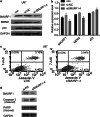Suppression of the Smurf1 Expression Inhibits Tumor Progression in Gliomas
- PMID: 28321604
- PMCID: PMC11481853
- DOI: 10.1007/s10571-017-0485-1
Suppression of the Smurf1 Expression Inhibits Tumor Progression in Gliomas
Abstract
Glioblastoma, one of the common malignant brain tumors, results in the highly death, but its underlying molecular mechanisms remain unclear. Smurf1, a member of Nedd4 family of HECT-type ligases, has been reported to contribute to tumorigenicity through several important biological pathways. Recently, it was also found to participate in modulate cellular processes, including morphogenesis, autophagy, growth, and cell migration. In this research, we reported the clinical guiding significance of the expression of Smurf1 in human glioma tissues and cell lines. Western blotting analysis discovered that the expression of Smurf1 was increased with WHO grade. Immunohistochemistry levels discovered that high expression of Smurf1 is closely consistent with poor prognosis of glioma. In addition, suppression of Smurf1 can reduce cell invasion and increase the E-cadherin expression, which is a marker of invasion. Our study firstly demonstrated that Smurf1 may promote glioma cell invasion and suppression of the Smurf1 may provide a novel treatment strategy for glioma.
Keywords: Apoptosis; Glioma; Migration; Smurf1.
Conflict of interest statement
The authors declare that they have no conflict of interest.
Figures





References
-
- Chen J, Sun J, Yang L, Yan Y, Shi W, Shi J, Huang Q, Chen J, Lan Q (2015) Upregulation of B23 promotes tumor cell proliferation and predicts poor prognosis in glioma. Biochem Biophys Res Commun 466(1):124–130. doi:10.1016/j.bbrc.2015.08.118 - PubMed
-
- Cohen ZR, Ramishetti S, Peshes-Yaloz N, Goldsmith M, Wohl A, Zibly Z, Peer D (2015) Localized RNAi therapeutics of chemoresistant grade IV glioma using hyaluronan-grafted lipid-based nanoparticles. ACS Nano 9(2):1581–1591. doi:10.1021/nn506248s - PubMed
MeSH terms
Substances
Grants and funding
LinkOut - more resources
Full Text Sources
Other Literature Sources
Medical

